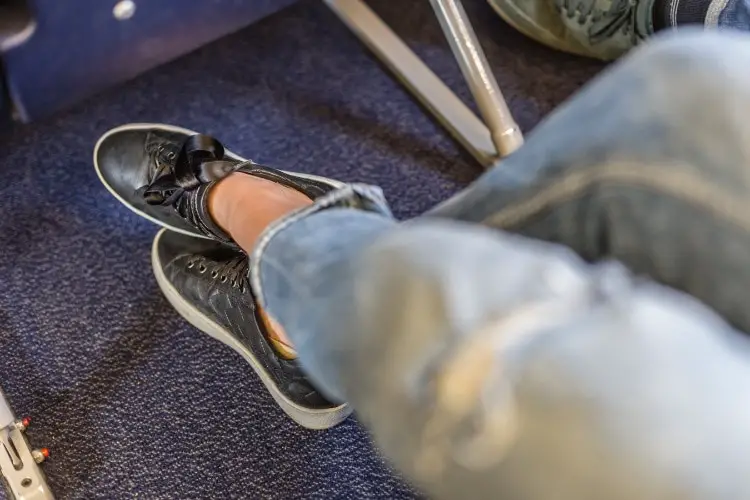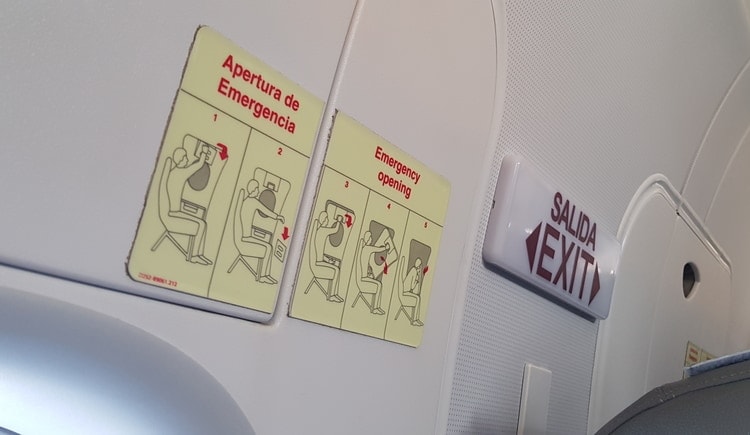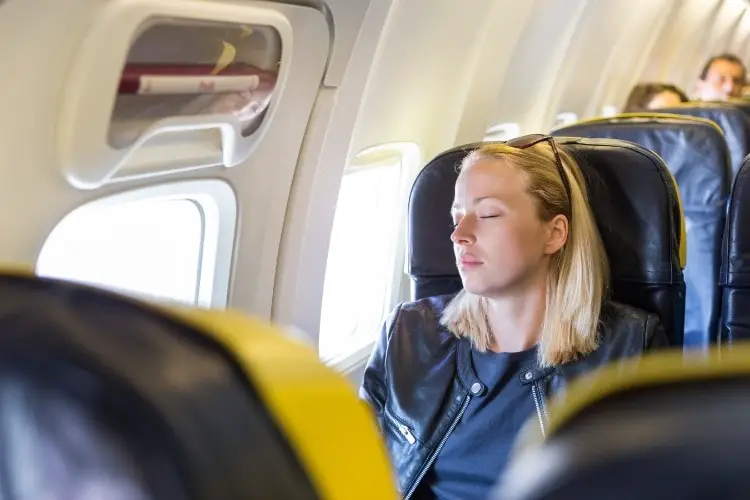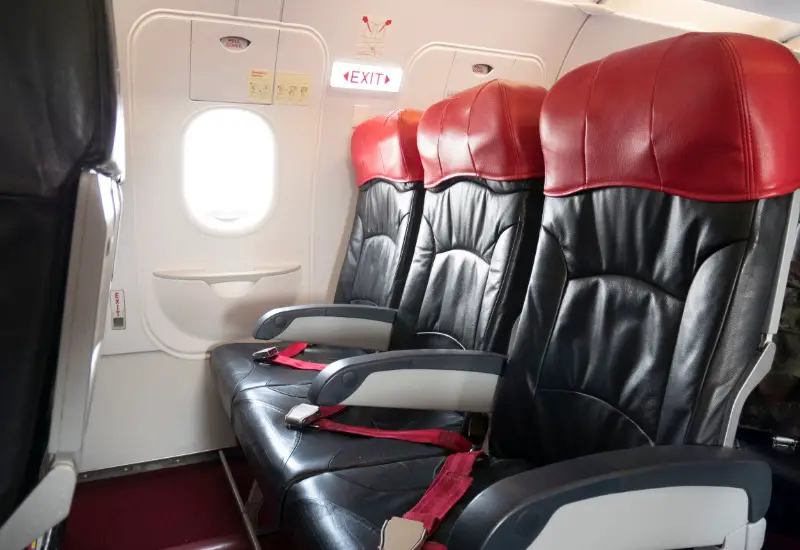Exit rows can provide you much more comfort and legroom when flying, but are they really better?
In this article, we’ll cover everything you need to know about the emergency exit row seats and provide you with information that will surprise you.
PROS
- More legroom, which means leg stretching and flexing is possible. Also, there is no need to wake up your neighbors to go to the restroom or get something out of your carry-on bag from the overhead locker. Personally, I find that a big advantage.
- If you are taller than average, you’ll definitely like the legroom of an exit row seat, and you won’t have to worry about the person in front of you reclining their seat.
- It’s a good option if you are in Economy and can’t afford the option of Business or Premium economy but still want at least some of the comfort.
- You sometimes get served first. But this isn’t a given, it depends on the airline and your particular seat.
- A good consideration for some: it’s the safest seat because you’ll be able to exit the plane faster in an emergency. At least, so it appears, but there is a disadvantage to that, as I’ll discuss in the Cons section.
- You don’t need to worry about kids sitting next to you as Federal law doesn’t allow it.
- Nervous fliers often feel a bit more relaxed because of the extra space and the proximity to the emergency exit.

CONS
- No bags allowed: flight attendants will not permit you to keep any bags in front of you. During takeoff and landing, they must be stored again in overhead compartments. You can have them back during the flight, but when it comes time to land, they will have to go back into the overhead compartment. The reason for this is pretty obvious; in case of an emergency, you don’t want a primary escape route to be blocked by bags and luggage. Or anything at all, come to that. However, this only applies when there is a bulkhead in front of you. This is when there is essentially a wall in front of you, with no space to stow your baggage. Some exit rows do have spaces where you can stow items the size of a backpack. You will need to ensure they do not block access to the emergency exit window. Check to see which one you will have, when booking your ticket(s).
- A little known fact is this one: the window seat can be cold. Cold air will leak in through the seal on the exit door and lower the temperature around you. Don’t worry, it’s perfectly safe, but your comfort level might not be what you had bargained for.
- If, as is the case on some aircraft, the emergency exit is by the wing, you will have a higher level of engine noise to contend with.
- In some models, the armrest can’t be lifted because the tray table often sits inside the armrest. The seat in this row can also be narrower. Not being able to move the armrest or solid divider can be really annoying on a long haul flight.
- You may have to pay extra to get an emergency row seat. And be aware that even if you do stump up with a slightly larger fare, if you don’t meet the physical requirements that I’m going to talk about shortly, then you still won’t be allowed to sit there.
- This is another Con to check out, it can be a game-changer for many: Not all exit row seats recline. If there are 2 exit rows one after another, the seats in the row in front are designed not to recline because if they did, it would block the second row in case of emergency.
- You will be asked to help in case of an emergency evacuation under instructions of the cabin crew to assist the crew and open the door in case of an emergency. You will be asked if you are willing to do this when you take your seat.
- Some airlines don’t allow passengers to sit in exit rows to use headphones during take-off and landing. This is to make sure you are able to hear the instructions of the flight attendants in case of an emergency. 80% of the accidents happen within the first three minutes of a flight or in the last minutes before landing. So those are critical, the most critical phases.
- You will be asked to keep the window shade open for take-off and landing. This is to ensure that you can see clearly if anything were to go wrong. Also, to prevent you from opening an exit that could be blocked/or unusable due to outside conditions (fire, debris, etc). If you plan on putting that shade down and sleeping the entire time, this is something you will have to prepare for.
Why can’t everyone have the choice of having a seat in an emergency exit row?
Because a passenger sitting next to the exit row has a huge responsibility: operating the exit in case of an emergency, which means that they must be fit and able to push open a door that can weigh up to 18 kg/39 lbs.

Requirements needed to be able to sit in an emergency row
In general, the requirements needed for a person to be able to sit in an emergency exit seat are:
- Physically fit and capable of opening the exit door. Sufficient mobility, strength, in both arms and legs, no medical conditions or visual impairment
- Be a minimum age (as established by the operator) for most, above 15. But it can vary between countries and airlines
- Not traveling with someone else who needs their assistance in case of an emergency
- No mental health issues
- Doesn’t need a seatbelt extension to fasten their seatbelt
- Not pregnant or seated with an infant
- Not elderly (age usually not defined, but will be a judgment call by the crew).
- Speak and understand English or be able to speak and understand the airline’s local language (French in France, Spanish, etc.) so that can follow instructions if needed
- Not traveling with a pet inside the cabin. Your pet cannot travel under the seat in front of you in an emergency row.
Let’s be clear, an emergency is extremely unlikely to happen, but airlines need to establish requirements to ensure that if one does, the people in the exit row meet certain requirements.
These are pretty much the same for all airlines with minor variations such as the age restriction (some companies will allow only adults, others only persons over the age of 15 and others only those over the age of 12).
FAQ
How much extra legroom is available in the exit row?
Each airline is different when it comes to how much legroom space is actually available. This could be due to the type of aircraft, or how the configuration of the cabin.
However, you can tell the difference between a normal seat, and an exit row seat, by far.
Do exit row seats come with windows?
All exit row seats come with windows, even if they are small windows.
This is so that the individuals sitting in these rows can see outside. This is imperative if something were to happen with the engine, or if there is an emergency evacuation, they need to be able to see outside to assess if it is safe to open those emergency exits.
Which seat in the exit row is considered the best?
I personally would say the window seat is considered the best, only because I like sitting at the windows, but this could be a difference of opinion.
You can assume that the window seat individual is going to be the person to actually open the emergency exit.
They are also going to be the first ones out of the plane, however, this could come with some risk, depending on the type of evacuation. If this were to happen. Many would choose to pick the aisle seat, just because you would be third in line when it comes to an emergency evacuation, and you have quick access to other parts of the cabin.
Is it possible to sleep in the emergency exit row?
Yes, you are able to sleep in the emergency exit row. There is nothing that stops you from being able to do this.
Do exit row seats recline?
You will find that most exit row seats are unable to recline. But, that depends on which exit row you sit in.
If there is a row of exit seats in front of you, your seat should be able to recline.
If you have a row of exit seats behind you, they will not recline. This is to stop anything from getting in the way of anyone’s egress. The paths to the exits need to be completely unobstructed.
Are exit row seats good for long flights?
Exit-row seats are wonderful for long flights. You have so much more room to stretch out. I would choose an exit row seat, over a normal seat, any time I had the choice to do so.
Which is better: bulkhead or exit row?
Exit row seat by far.
Bulkhead rows you have to put all of your items up for take-off and landing.
Exit row seats usually have a place under the seat in front of you to stow some of your smaller items.
Exit row is also going to get you out of the plane faster, but you do have to operate the emergency exit on your own.
Exit row seats also have more legroom, bulkhead rows may seem like they have more space, but they have the same amount of legroom as a normal seat.
Conclusion: Is it worth paying exit rows? Are these seats better?

This really is your call, but here are the sorts of considerations that will help you to make your decision.
Choose what is important to you and remember to factor in, what is fine for a short-haul flight, is often not good for a long-haul one.
You should pay an exit row:
- If you want to sleep, e.g. on an overnight flight, there is more room for both leg stretching and tossing and turning.
- If you are taller than average, you won’t spend the flight in the misery of being cramped up in your seat.
- If you don’t want to be sitting next to a crying baby, a child, or someone who is perhaps larger than airline seats are designed for.
- If the airline you are flying has a very reduced seat pitch in economy.
- If the flight is long (over 4 hours) and you know you will need to stretch your legs
You shouldn’t pay an exit row:
- If the flight is short. Ask yourself: Do you really need it for a flight of under 2-3 hours? Would you pay $75-$100 for the privilege? Or, in other words, $50 an hour?
- If you are very sensitive to the cold. This isn’t the place for you.
- If the ability to sleep is a major consideration, remember that the solid dividers in an emergency exit row can’t be removed, so you may be better off (if you can) laying down in a row with empty seats in it.
- If you want to keep all your belongings with you under the seat, then the emergency exit row is not for you.
- If you like to recline your seat, this can’t be done if there are two emergency rows. In this case, choose to sit in the second row. Pick the second row if there are two.


Awesome info . I’ve been on many flights both in India and Europe but this was my first experience with the emergency exits . I was just offered an exit row seat coz the flight was hardly occupied and airline rules apparently say that there should be atleast one person occupying these seats . And most of my previous travel was with kids so I’m not surprised I have never been offered this before !! I’m glad I said yes . It had lots more leg room . Im waiting for my connecting flight and will request the airhostess for a second row exit seat . I may not get it , but I’ll anyways try . No harm in trying !! The worst would be a ‘ No’ to my request . But thanks for this , makes everything crystal clear .
Is their television attachment in front of an exit chair
If there are screens in that aircraft, there will be too for the exit row seats.